FTA (изд-во). Flexography: Principles And Practices. Vol.1-6
Подождите немного. Документ загружается.

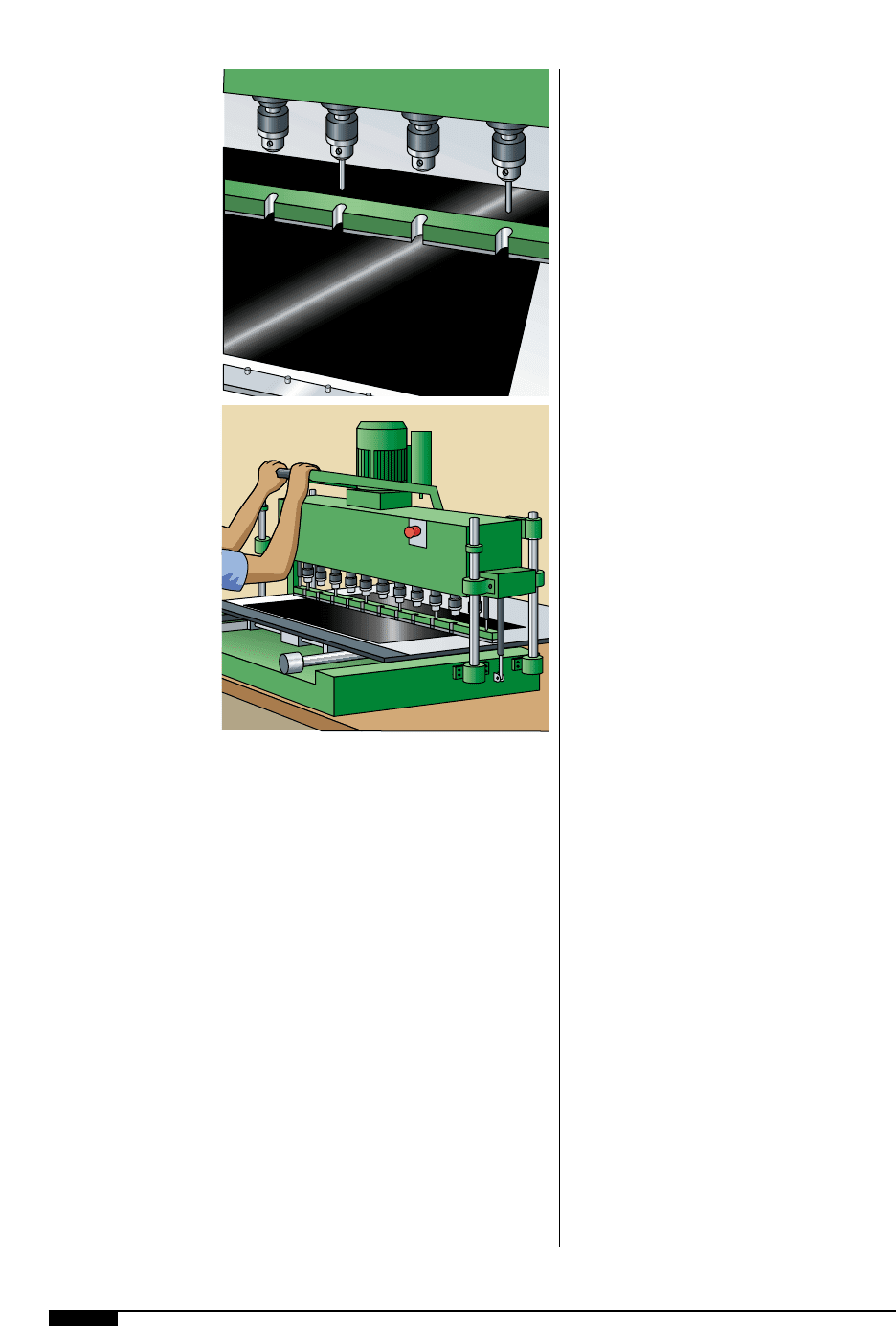
86 FLEXOGRAPHY: PRINCIPLES AND PRACTICES
the film, plate- and press-mounting process.
Thick, elastomeric flexographic printing
plates do not punch easily – especially in the
uncured state; with liquid photopolymers, it
is practically impossible. As an alternative,
drilling plates has been found to be a suitable
method. In addition to drilling the plate mate-
rial, a procedure is required to use pin regis-
tration during the mounting operation with-
out extensive modification to the press cylin-
der. One solution is to mount a temporary
pin-registration bar on the printing cylinder.
System Components
A pin-registration system for sheet pho-
topolymer plates consists of two parts: a film
and plate drill, and a registration bar. The
film and plate drill (Figure
4%
) is used to
place up to 11 registration holes in a line
across the film and plates. The drill can be
positioned to avoid drilling holes in image
areas, and individual drill bits can be
removed. The standard drill table accepts
plates up to 41" but can be modified to
accept wider plates.
The second part of the system is the regis-
tration bar. This is a portable bar that clamps
securely to the printing cylinder. Registration
pins on the bar are aligned with the holes
drilled in the plates. Plates mounted on these
pins are in precise alignment with the cylin-
der. Registration bars are available up to 112"
wide with either fixed or sliding pins.
Preparation for Pin Mounting
1. Select hole locations for drilling the
film, avoiding any image areas. A com-
posite proofing film that has been
exposed to show all printing plates on
one film helps in this step. Remove any
unwanted drill bits (Figure
4%
).
2. Assemble plate-making films in position
over each other. Align plates by the reg-
istration marks made during the film
preparation step.
3. Drill pin-registration holes in the assem-
bled plate films simultaneously while
they are held in place by the reigstration
pins in the punched holes used during
the film preparation steps (Figure
4^
).
During this step, a transition is made
from the punched film-register system
to the drilled plate-register system. This
is a critical step.
4. The printing plates are prepared for
drilling. Cut the individual plates to size
for each color, then back expose to pro-
duce smoother drilled holes. The imag-
ing face is not exposed.
5. Drill pin-register holes in each of the
prepared plates, one at a time.
6. Position the drilled plate and negative
together on the registration pins for
exposure.
4%
The initial step in pin
mounting requires
determining the hole
locations and removing
the unwanted drill bits.
4^
After the hole locations
are determined, the
plate-making films are
positioned over each
other and pin-registra-
tion holes are drilled.
4%
4^
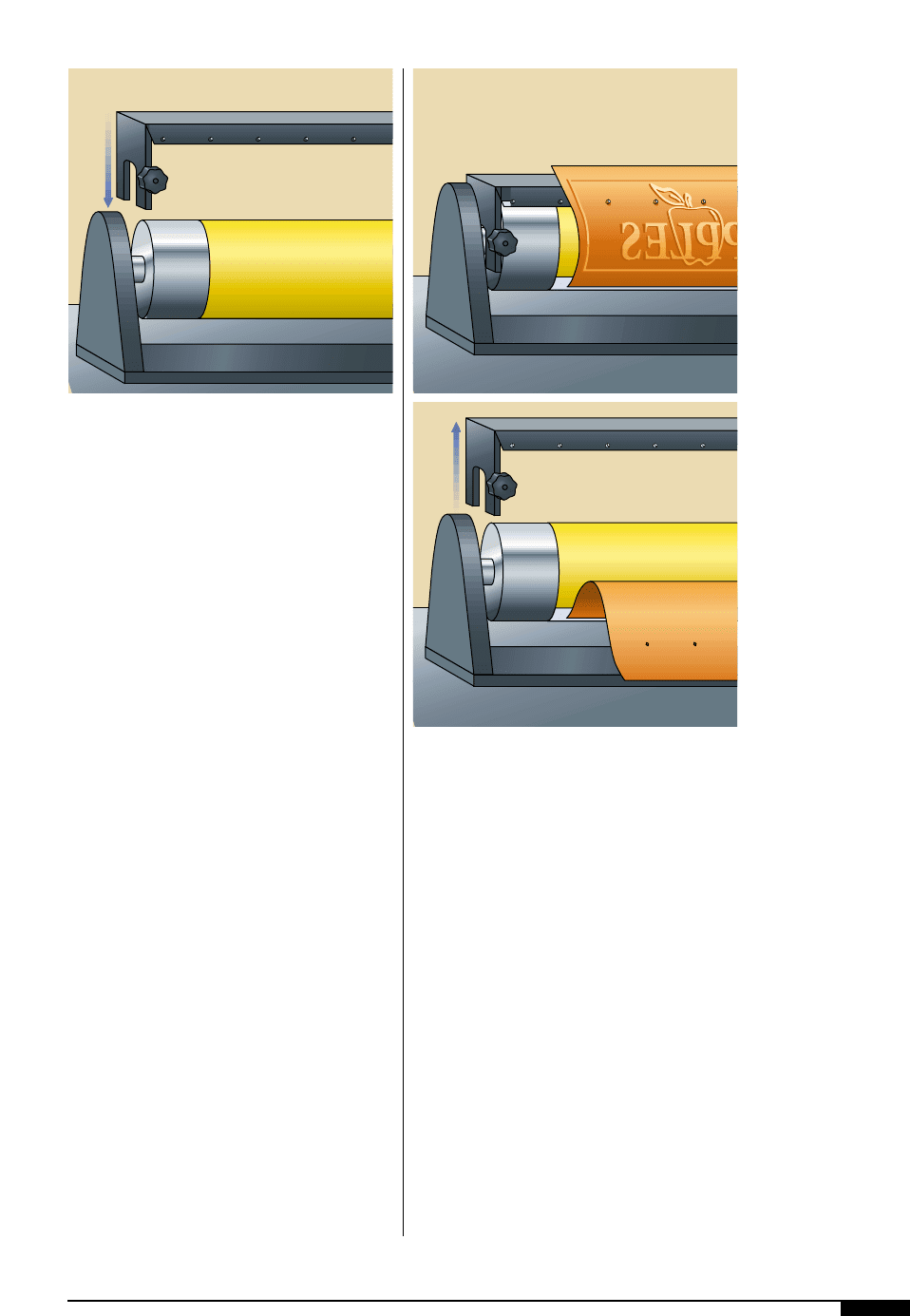
7. Use the standard plate-making proce-
dures for sheet photopolymer plate-
making to process the plates.
8. Repeat steps 6 and 7 for all plates for
the job.
Procedure for Pin Mounting
Pin-registration bars can be used for
mounting to the plate cylinder either on the
mounting and proofing machine (if an inked
proof is required before going to press), or on
the cylinder rack (if no proofing is required).
The following procedure should be used:
1. Attach the registration bar to the plate
cylinder by clamping the bar end-plates
to the bearing surfaces of the plate
cylinder shaft (Figure
4&
). This accu-
rately aligns the pins on the bar to the
plate cylinder.
2. Select the required drill-hole locations
and remove unused pins from the regis-
tration bar.
3. Apply stickyback to the plate cylinder
in the conventional way, then remove a
small portion of the backing paper.
4. Position the printing plate over the pins
on the bar.
5. The plate should then be held tightly
between the bar and the plate cylinder
while contact is made with the sticky-
back.
6. Smooth the first portion of the plate
down onto the sticky-back (Figure
4*
).
Remove the plate from the pins, then
remove the pin registration bar from the
plate cylinder (Figure
4(
).
7. Remove the rest of the backing sheet
from the sticky-back and smooth the
plate onto the plate cylinder.
Advantages of Pin Mounting
Pin mounting provides fast, easy, accurate
mounting. Complex, normally time-consum-
ing mounting jobs can be reduced to a few
minutes per cylinder. It is especially advan-
tageous in permitting accurate mounting of
one large plate per color carrying many
small repeats, resulting from step-and-repeat
imaging techniques. This process eliminates
MOUNTING AND PROOFING 87
4&
Accurately aligning
the pins onto the regis-
tration bar of the plate
cylinder requires the bar
to be attached to the
plate cylinder by clamp-
ing the bar end-plates to
the bearing surface of
the plate cylinder shaft.
4*
The next step requires
smoothing the plate
down onto the sticky-
back
4(
In this final step, the
pin registration bar is
removed from the plate
cylinder.
4&
4(
4*

88 FLEXOGRAPHY: PRINCIPLES AND PRACTICES
the time and registration difficulty of mount-
ing many small plates per cylinder.
Pin mounting minimizes differences in
labor-intensive conventional mounting meth-
ods and reduces press setup. Mounting times
are multiplied as jobs are rerun.
Even when using a pin-mounting system,
however, proofing for accuracy and mak-
eready is still recommended.
PIN-REGISTER
MOUNTING SYSTEM II
This registration system combines the
accuracy of pin registration with the versatil-
ity of computer-controlled micro-video cam-
eras for locating imaged register marks. The
system provides for the alignment of the
plate cylinder, preplate positioning, punching
or drilling of negatives or photopolymer
plates for accurate register and mounting.
The technology for negative and printing-
plate alignment is adapted from the same
registration techniques used in the electron-
ics industry for aligning multilayer printed
circuit boards. The equipment includes a
planning grid sheet, target punch, optical
plate punch, plate mounter and pin-bar
mounter. The plate mounter is adjustable for
various sized cylinders.
System Components
A planning grid sheet, which consists of a
30" x 40" polyester sheet, is laser-plotted
with 37 intersecting lines spaced in 1" incre-
ments. The intersecting grid lines are identi-
fied by numbers and letters along the side
and bottom margins. Along the top edge is a
series of five punched slots, one vertical,
flanked by two pairs of horizontal slots.
The film is then punched using a target
punch, a precision, air-actuated film punch
(target punch) that creates target slots in the
negative at any selected grid line intersect-
ing point with an accuracy within 0.001"
(Figure
5)
). The vacuum table holds the film
flat and immobilized during punching. Ori-
ginal art and negatives for new jobs, as well
as existing negatives in inventory, are target-
slotted for pin-register platemaking.
An optical plate punch punctures a series of
registration slots in the fully processed print-
ing plate, aligning with the target slots in the
negative (Figure
5!
). The plate punch uses a
high-resolution micro-video camera, closed-
circuit, split-monitor screen at 20x magnifica-
tion to facilitate operator location and align-
ment of register punching targets. Punching
accuracy is within 0.001" punch to target, and
0.0005" repeatability plate-to-plate.
The plate punch uses a center-zeroing ver-
tical slot and a series of horizontal slots left
and right of center along one edge. It is
thought that this slotting configuration caus-
es less buckling or stretching of the plate
than is sometimes associated with other pin
shapes.
The plate mounter is a free-standing, plate-
cylinder holding device, under which is
located a plate-mounting pin bar that pivots
up and permits the retractable plate-holding
pins to contact the stickyback-covered cylin-
der (Figure
5@
).
Procedure for Punching Negatives
When punching negatives, use the follow-
ing procedure:
5)
In this pin-register
system, the film is held
flat and immobilized on
the vacuum table, while
holes are punched with-
in an accuracy 0.001"
by a precision, air-
actuated punch.
5)
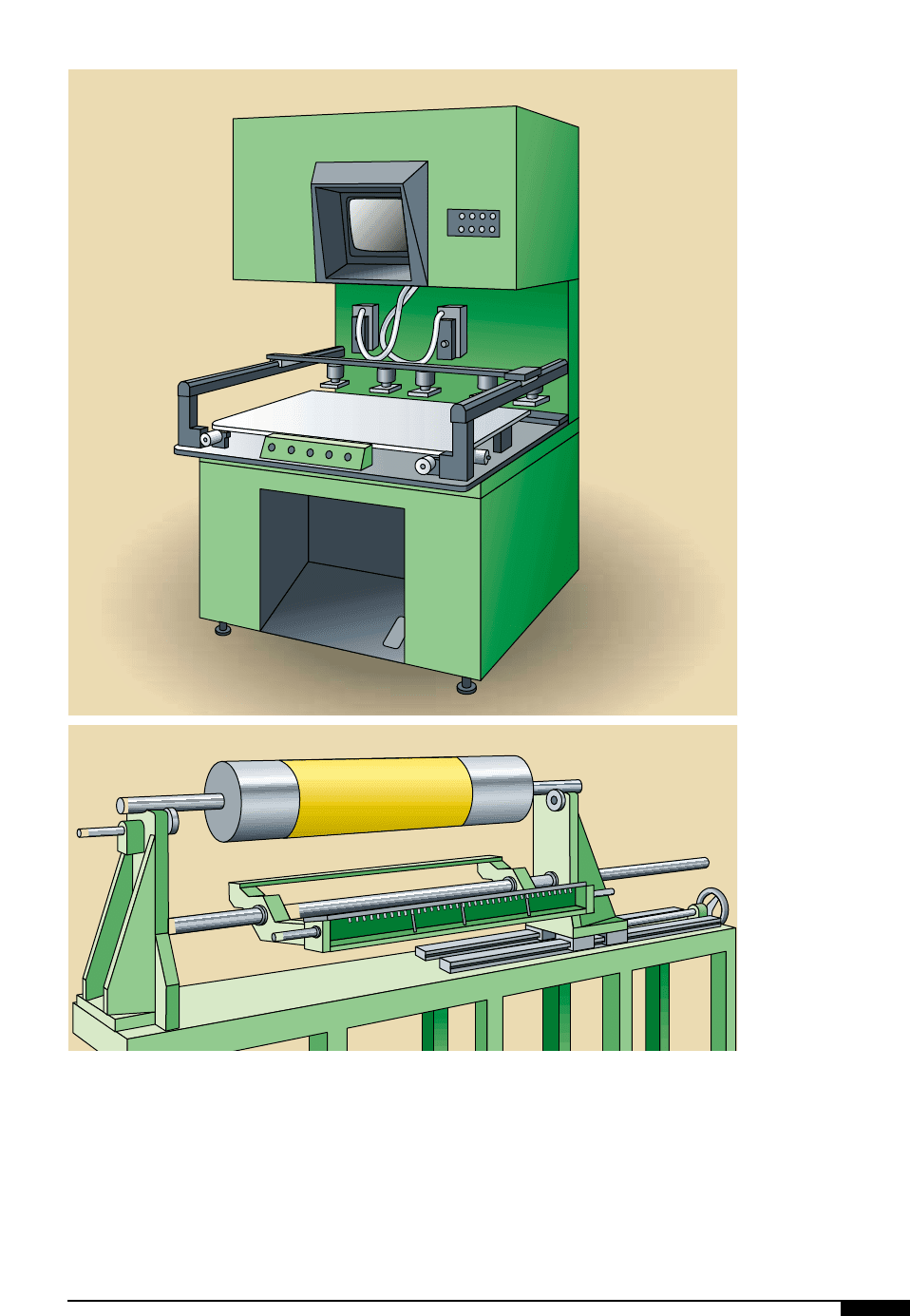
MOUNTING AND PROOFING 89
5!
By using a high-resolu-
tion micro-video cam-
era, a closed-circuit,
and a 20x split-monitor
screen, this plate-punch
unit offers a punch-to-
target accuracy of
0.001" and a plate-to-
plate repeatability of
0.0005".
5@
On the plate mounter, a
plate-mounting pin bar
pivots up from the print
cylinder to allow the
retractable plate-holding
pins to contact the
stickyback-covered
cylinder.
5@
5!
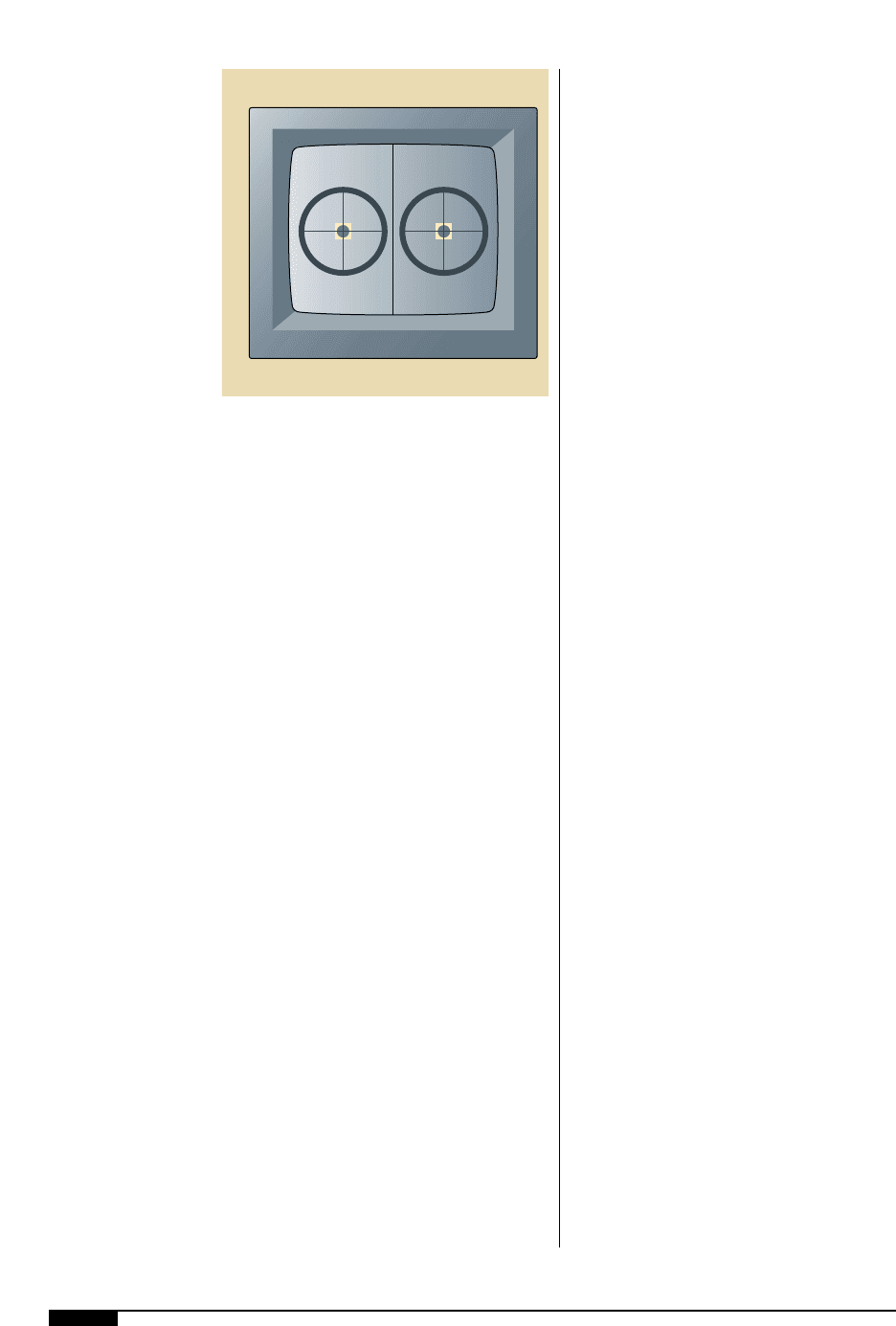
90 FLEXOGRAPHY: PRINCIPLES AND PRACTICES
1. Place a transparent, prepunched ace-
tate “carrier sheet” over the planning
grid sheet. This allows the grid pattern
to be seen clearly.
2. Place the first negative on top of the
carrier sheet and planning grid. The first
negative can be a composite, entire
repeat-stripped working negative or a
composite entire repeat-finished nega-
tive. The planning-grid sheet represents
the plate cylinder divided into set areas.
3. Select the best position for the printing
plates on the plate cylinder by moving
the negative or job layout composite of
negatives into that position on the grid.
Tape the negative to the acetate carrier
sheet in that position.
4. Select two target-punch positions, out
of the image areas, along the grid-sheet
– line “A” or “B” – corresponding to the
inner or outer slotted holes, and record
these grid-intersecting point numbers
and letters on a job-specification sheet.
5. Establish the plate-punch positions on
the “y” line along the top of the negative
and record these positions on the job
sheet.
6. Move the acetate carrier sheet, with its
negative taped into position, to the target
punch. Position the air-activated target
punches to coincide with the target loca-
tions chosen on the grid, and punch the
two holes at the targets locations in the
negative simultaneously (Figure
5)
).
Procedure for Punching
Printing Plates
The following procedure should be used
when punching printing plates:
1.Lay out the same grid reference points
on the vacuum table’s optical-plate
punch as the negative target punch. This
allows the two closed-circuit video cam-
eras and plate-punch heads to move into
those same positions. The cameras pro-
ject electronic crosshairs and the plate-
punch targets on the split-screen moni-
tor, enlarged to 20x (Figure
5#
).
2.Move the two cameras and the two
plate-punch heads into the recorded
grid-reference target points, selected in
the planning stage and taken from the
job specification sheet.
3.Refine the alignment of the camera
crosshairs and the punch targets with
the micrometer adjustments provided.
4.Place the fully processed printing plate
on the vacuum table and align with the
plate-target register marks, using the
microvideo monitor. Further refine tar-
get positions by moving the adjustable
vacuum table holding the plate.
5.Move the cameras and their transverse-
holding bar to the plate-punch position-
ing line, recorded on the job sheet.
6.Move the punches into the recorded
punch positions.
7.When camera crosshairs and plate tar-
get marks are precisely aligned on the
split-screen video monitor, activate the
punching button and punch the plate.
This entire procedure takes less than one
minute and should be repeated for each
printing plate.
5#
Electronic crossharis
and plate-punch targets,
enlarged 20x, as seen
on the split monitor of
the computerized plate
punching unit.
5#
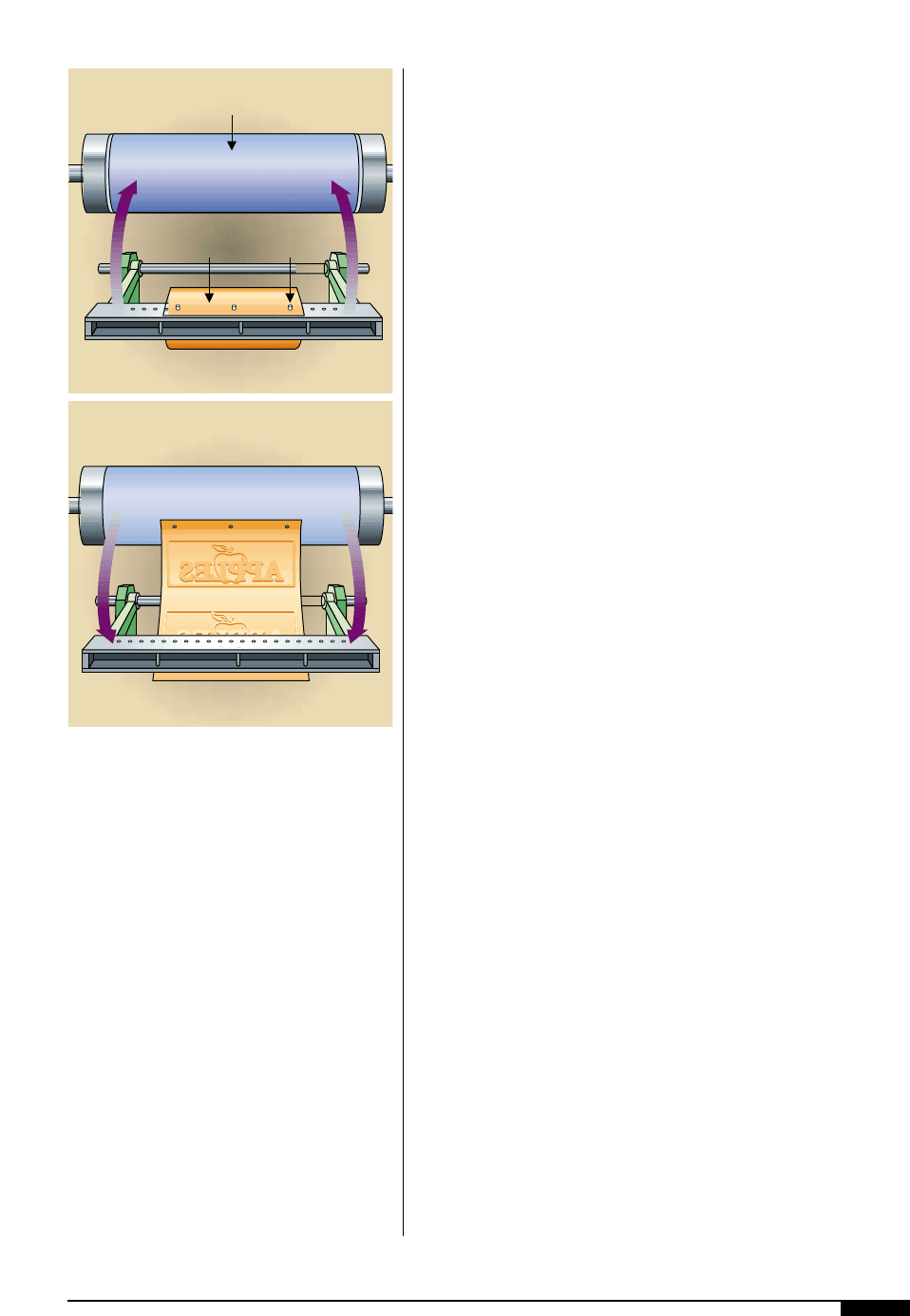
Procedure for Plate Mounting
For this process, use the following proce-
dure:
1. Place the first plate cylinder on the
plate mounter.
2. Position the plate cylinder journals into
a set of preloaded bearings.
3. Apply stickyback to the plate cylinder
in the conventional way. This may be
done with the cylinder off the mounting
machine.
4. Find the pivoting pin-bar mounter,
which is located below the plate cylin-
der. Locate the pins in the pin bar at the
numbered positions given on the job
sheet.
5. Load the first plate onto the retractable,
spring-loaded pins that hold the plate to
the pivoting pin bar. (Figure
5$
).
6. Remove the protective cover sheet
from the stickyback.
7. Pivot the pin bar until the leading edge
of the plate and retractable pins come
into contact with the stickyback. Push
the bar until the pins retract and the
plate sticks to the cylinder across the
entire leading edge, releasing itself from
the pivoting bar.
8. Lower the pin bar (Figure
5%
) and
rotate the plate cylinder slowly as the
remainder of the plate is smoothed
down.
Repeat these steps with all plate cylinders
for the job. The actual mounting of each
plate takes less than one minute. In most
cases, cylinder handling and mounting for a
six-color job takes less than one hour.
Advantages of the System
The pin-mounting system provides accu-
racy and speed of registration and mount-
ing. It moves the responsibility for registra-
tion to the planning stage when plates are
prepared.
The system provides the ability to accu-
rately mount multiple plates around and
across the cylinder and to nest images.
Mounting multiple plates often eliminates
the need for step-and-repeating negatives
and mounting large, unmanageable plates.
PLATE MOUNTING TO PINS
IN THE PLATE CYLINDER
This system requires the printer to have
the inventory of plate cylinders drilled with
tiny holes to accept the 0.094" diameter shaft
of the pins used for mounting. The holes in
the cylinder must be precision bored, both in
diameter and position, in order to correlate
to the holes punched into the printing plate.
The system will work with any plate cylinder
width or circumference from 6" to 80".
MOUNTING AND PROOFING 91
5$
The plate is loaded onto
the retractable, spring-
loaded pins to hold the
plate to the pivoting pin
bar.
5%
The pin bar is lowered
and the plate cylinder is
slowly rotated until the
remainder of the plate is
smoothed.
Exposed
Stickyback
Retractable
Pins
Back of
Plate
5$
5%

92 FLEXOGRAPHY: PRINCIPLES AND PRACTICES
The pin registration system is as follows:
1. Produce mechanical artwork with pin
placements indicated at the center of the
repeat and at a set distance from each
edge of the web. Make a web layout
showing pin placement and dimensions.
2. Prepare and make one-up negatives
using the pin placements as shown on the
black-and-white mechanical artwork.
3. Blind punch (before imaging) the nega-
tives with the holes for the pins and the
images are step-and-repeated in multi-
ples to form a single plate image
(Figure
5^
)
4. Make and lay a color key on pins corre-
sponding to the artwork. This is a posi-
tive register control. If the color key is in
perfect register, the plates will reflect
this. This step ensures that negatives are
correct for color separation, register,
size and that the pinhole locations are
accurate. Although this step is not essen-
tial, it is a way to verify film accuracy.
5. Punch a sheet of photopolymer plate
with the same hole placement as the
negatives and color key. Do this after
back exposure, but before imaging the
plate material.
6. Place the pins into the punched holes of
the photopolymer plate and place the
pin bar over the pins.
7. Expose the photopolymer plate to the
negative.
8. After exposing the negative, remove the
pins. Process, dry, cure and finish the
plate. It is ready to be mounted on the
cylinder.
9. Cover the plate cylinder with sticky-
back.
10. Uncover the pinholes in the cylinder by
removing only a small piece of the
stickyback.
11. Remove the small strip of the protective
cover paper from the stickyback
between the pinholes and insert the
pins into the pinholes in the cylinder.
12. Place the plate onto the stickyback with
the punched holes fitting over the pins
(Figure
5&
).
13. Remove the rest of the stickyback cover
paper and smooth the plate uniformly
around the cylinder.
14. Remove the pins from the cylinder. It is
now ready to be positioned in the press.
DIGITAL PIN REGISTRATION FOR
CORRUGATED POSTPRINT
Computerized pin registration harnesses
the digital prepress information to improve
mounting accuracy. The system significantly
reduces mounting time compared to conven-
tional corrugated plate mounting, where sev-
eral plates carrying image elements are
5^
The negative is blind
punched with holes for
the pins and the images
stepped and repeated to
form a single plate
image.
5&
The plate is affixed to
the stickyback with the
punched holes fitting
over the pins.
5^
Exposed
Stickyback
Stickyback removed
from cylinder, pin
inserted in pinhole
5&
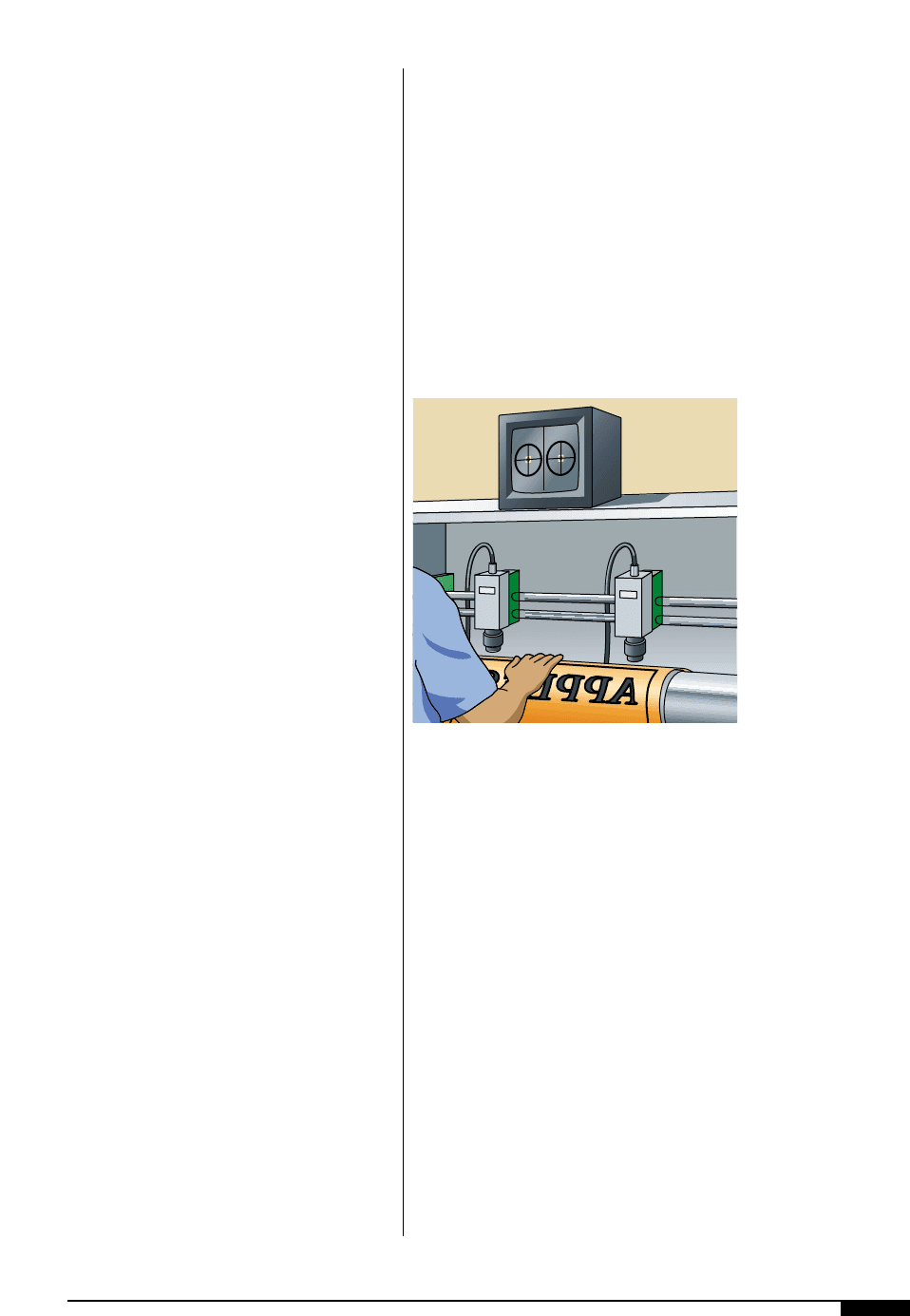
MOUNTING AND PROOFING 93
5*
Computer software
assigns “x” and “y”
coordinates on the plate,
which tells the computer-
controlled drill the loca-
tions for the drill holes.
5(
Two video cameras,
positioned just above
the plate cylnder, assist
in the alignment of one
color plate to another.
Registration is achieved
through the use of two
micro dots placed on
the plates and imaged
by the video camera at
a 140x magnification.
assembled and positioned on a single carrier.
In conventional plate mounting, the individ-
ual plate elements are positioned by looking
through a semitransparent mirror using eye-
to-hand coordination. Both the viewing and
the manual placing of plates induces errors
which cannot be tolerated as increased print
quality demands tighter print registration.
To use this technology, registration marks
are added to the graphics and their positions
are recorded in the digital file during the pre-
press stage. These register marks are output
to the negatives and thus are captured on the
plates when they are made.
During the insertion of the register marks
to the graphic elements, the software
assigns “x” and “y” coordinates to these posi-
tions. The coordinates are then sent to a
computer-controlled drill (Figure
5*
), which
drills the holes in the plate carrier sheet in
the precise positions for locating the print-
ing plates. The individual photopolymer
plates, with the register marks on them, are
drilled to accept register pins using the same
drilling machine.
Double-sided stickyback is applied to the
back of the printing plate ready for mounting
on the carrier sheet. Pins are then inserted
through the back of the carrier sheet and the
holes in the plates are aligned with the pins
to precisely position the plates in the proper
relationship. Accuracy of this technology is
quoted at 0.001" up to a 5" x 80" drilling area
for all colors. Productivity can be increased
even further by prepunching the carrier
sheets and drilling all the colors for a multi-
color job at the same time.
When this is done, a predrilled fastening
bar is used which contains holes that are
positioned exactly to the holes created when
the carrier sheet is punched. Special plastic
fastening pins are then used to attach the bar
to the carrier sheet. This assures the fasten-
ing bar is always square to the image, elimi-
nating the need to “cock”, or reposition the
lead-edge slot in the printing cylinder, thus
reducing press makeready time. Using this
technology, plates can be mounted “in the
round” or flat, depending on customer spec-
ification.
VIDEO-MOUNTING SYSTEMS
The latest approach to alignment of one
color plate to another in the mounting
process is through the use of video cameras
(Figure
5(
). Registration is achieved
through the use of two micro dots placed on
the plate and imaged with the video camera
at a typical magnification of 140x. The micro
dots are 0.01" in diameter and are put in
exactly the same location on each color
plate. They are placed on the left and right
side of the copy and in the center of the
5*
5(
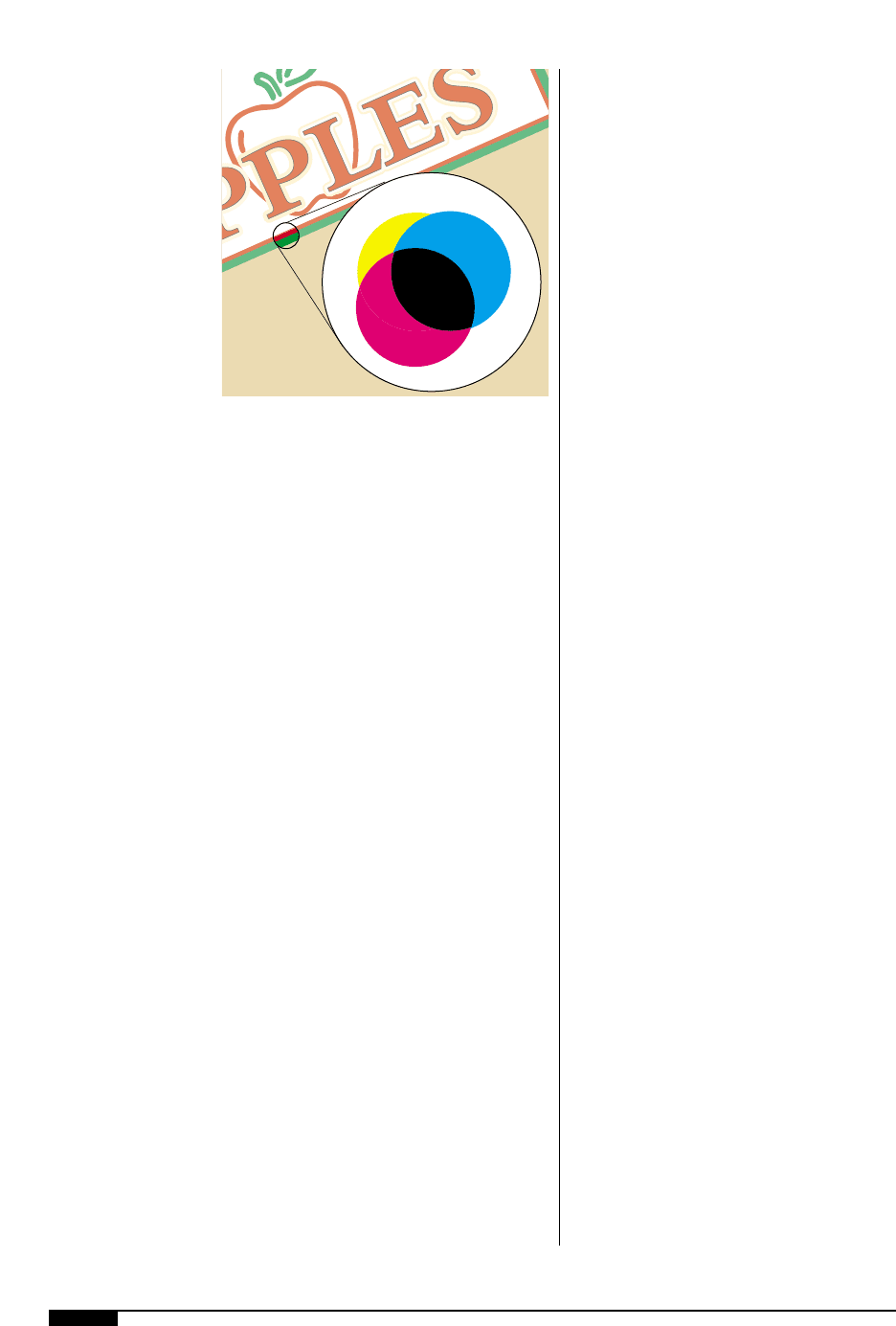
94 FLEXOGRAPHY: PRINCIPLES AND PRACTICES
copy’s web direction (Figure
6)
). When the
job is in register, the dots will overprint each
other and appear to be an almost perfect dot.
Figure
6)
shows an enlargement of four
micro dots of the process colors. Perfect
alignment would be a single black dot with
no other colors showing. Using micro dots,
plate-to-plate registration to within 0.001"
can be achieved.
The procedure for mounting using micro
dots is as follows:
1. Position the camera of the mounting
system directly above the cylinder.
2. Apply stickyback to the first print cylin-
der
3. Remove the protective cover sheet
from the stickyback.
4. Cut two strips of cover sheet and place
it back on the stickyback in such a way
as to leave a strip of exposed sticky-
back under the cameras.
5. Align the micro dot on one side of the
copy with the camera.
6. Move the camera on the other side
along the cylinder direction and move
the plate to align the micro dot.
7. Lock down the camera and “tack” the
plate to the exposed strip of stickyback.
8. Remove the rest of the cover sheet and
smooth the plate onto the rest of the
cylinder.
Once the first plate has been mounted,
leave the cameras in place and mount the
subsequent plates with their micro dots
aligned to the cameras. While video mount-
ing gives excellent alignment, it is still rec-
ommended to proof the job before going on
press. This will reveal that no other make-
ready is needed or point out areas where
makeready (including correcting high or low
spots) can help to make the job run more
smoothly on press.
SLEEVE-MOUNTING SYSTEMS
Fast… Effective… Economical – these
characteristics are causing sleeve mounting
systems to be widely embraced by the flexo-
graphic printing industry. Sleeves, (Figure
6!
) carrying prepositioned printing plates,
can be quickly and easily mounted to, or
removed from, a press cylinder. These
devices prived considerable advantages to
the printer, all of which contribute to
reduced costs and increased efficiency. For
example:
1. With the addition of only one more plate
cylinder, a multicolored job can be pre-
mounted while another job is running.
This is especially useful when only a limit-
ed number of plate cylinders are available
for a particular print repeat size.
2.Repeat jobs can be stored on sleeves,
which saves mounting time and plate and
stickyback costs. The next time the job is
run, it is simple to remount the sleeves
and rerun the job. The plates are not dam-
aged because they are not manhandled in
any way since they were last in the press.
3.Jobs stored on sleeves can be easily
remounted and will print in register. This
can save time on difficult-to-register jobs.
4.Press downtime is reduced.
5. Continuous design printing plates may be
formed on sleeves by coating them with
either unexposed photopolymer or vulcan-
ized rubber, which can be subsequently
6)
An enlargement of four
micro dots of the
process colors. Perfect
alignment would be a
single black dot with
no other colors show-
ing. Using micro dots,
plate-to-plate registra-
tion to within 0.001"
can be achieved.
6)
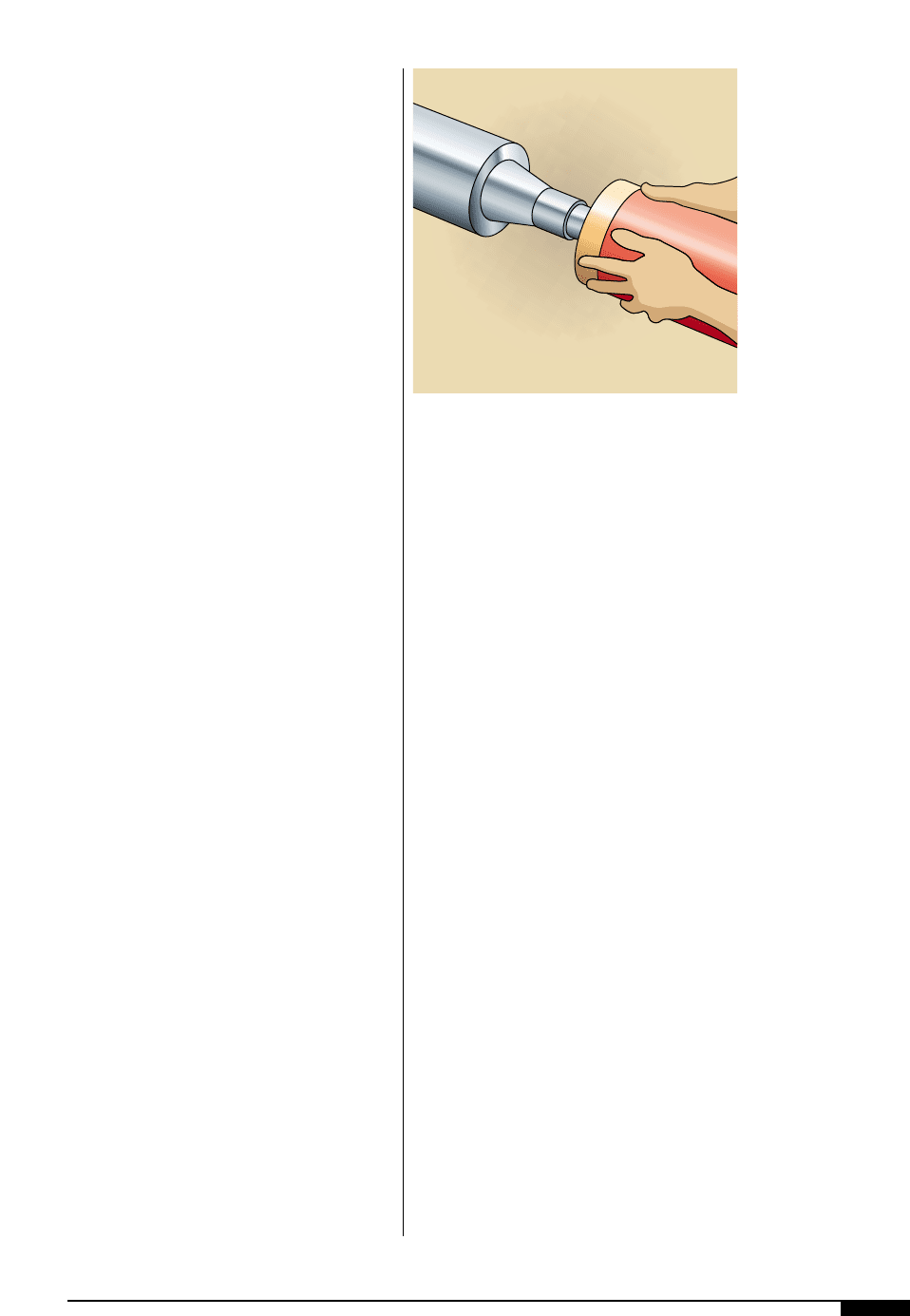
engraved by light exposure or laser. By the
same process, covered sleeves are ideally
suited for solid flood coating and tint or
varnish applications, allowing the oppor-
tunity to use only one plate cylinder for
this purpose
6. Sleeve storage is easier and more conve-
nient than plate cylinder storage, particu-
larly on larger cylinders. Many convenient
forms of storage are available, depending
on the sleeve manufacturer. Sleeve stor-
age is simplier due to the ease of handling
a mounted sleeve which is much lighter
than a plate cylinder. Transportation costs
are also reduced dramatically and over-
night shipping becomes feasible and
affordable.
7. Flexibility is achieved by obtaining differ-
ent repeat ranges from the same diameter
plate cylinder. This is possible by mount-
ing sleeves of different thicknesses. By
careful calculations, the repeat size may
be increased by the precise amounts that
coincide with what will be needed to
match extra teeth on the gear. This is done
by using rubber-covered sleeves or thicker
composite sleeves.
8. Sleeves allow a printer with a large stock
of cylinders undercut for a certain plate
thickness and mounting tape to change to
a thinner plate. The decrease in the under-
cut for the thinner plate can be compen-
sated for by increasing the thickness of
the sleeve.
9. The majority of sleeve systems permit the
cutting and trimming of plates once they
are mounted on the sleeve. Obviously,
care has to be taken not to perforate the
sleeves.
The most important characteristic that the
sleeve must demonstrate is that it will not
slip. Unless this can be guaranteed, the
sleeve cannot be used for quality flexo print-
ing. A sleeve that slips is unacceptable due
to the serious deterioration of print quality
and the impossibility of maintaining register.
TYPES OF SLEEVES
There are basically two types of sleeve
systems: parallel (or cylindrical) and tapered
(or conical). Parallel sleeves have constant
and parallel inner and outer diameters and
are designed to be mounted on existing plate
cylinders. Tapered sleeves have a tapered
inner diameter and constant outer diameter
and are designed to mount on matched,
tapered mandrels or cylinders.
Sleeves are available in different materi-
als, depending on either the printer’s per-
sonal preference or the type of application.
The nickel sleeve is the thinnest sleeve
available and has a standard wall thickness
of 0.005". It permits the printer to become a
sleeve user with minimum modification to
existing equipment. The only modifications
required are:
• Appropriate air holes need to be drilled in
the plate cylinder.
• Thinner stickyback must be used for
mounting the plate on the sleeve to com-
pensate for the extra 0.005" thickness. The
same thickness plate can be used.
Nickel sleeves are produced by plating
nickel electrolytically onto a very precise
MOUNTING AND PROOFING 95
6!
Plates are monted on
a sleeve, which is then
slid over the print
cylinder with the aid
of air pressure. After
the run, the sleeve is
slid off the cylilnder,
plates intact, and stored
for future pressruns,
which will be marked
by a drastic reducion in
setup time. Pictured is a
Strachen Henshaw
sleeve.
6!
